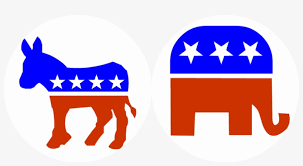In the aftermath of the 2020 election, and following the pro-Trump extremist mob that attacked and overran the United States Capitol, it seems that thousands of voters decided to change their party affiliation. Overwhelmingly, the trend has been away from the Republican (GOP) party.
In fact, in only a few days since the Jan. 6 insurrection at the Capitol, a statistical report by The Hill, reveals that more than 30,000 registered Republicans changed their party affiliation; most moving from Republican to unaffiliated. The states with some of the largest numbers of affiliation shifts: Pennsylvania, Arizona, North Carolina, Maryland, Colorado and Florida.
 The trend is not one-sided. In Pennsylvania, almost 10,000 Republicans parted ways with the GOP by January 25. Of those, 3,476 changed their registration to the Democratic Party. The rest moved to a third party or remained unaffiliated. But during the same period in Pennsylvania, some 2,093 Democrats switched to the Republican Party, while 1,184 become unaffiliated or switched to a third party.
The trend is not one-sided. In Pennsylvania, almost 10,000 Republicans parted ways with the GOP by January 25. Of those, 3,476 changed their registration to the Democratic Party. The rest moved to a third party or remained unaffiliated. But during the same period in Pennsylvania, some 2,093 Democrats switched to the Republican Party, while 1,184 become unaffiliated or switched to a third party.
Not all states actually report voter affiliation shifts on a regular basis, so it isn’t known what the full voter shift has been. Voters changing party affiliation is a relatively common activity.
But those who regularly report on voter registration say the recent surge of voters leaving the GOP is unusual because that number of registration shifts normally happen prior to an election. But now, they are happening after the election, and the trend accelerated after the deadly Capitol breach, which happened after former President Donald Trump pushed false claims that President Joe Biden had “stolen” the presidential election.
Just under 4,600 Colorado voters have shifted their party affiliation in the wake of the deadly Capitol breach. Shifts have occurred across most of Colorado’s 64 counties, including those in deep red counties such as Weld County. The vast majority, 4,200 switched from Republican to unaffiliated status. The defection trend was most obvious in Douglas County, a former Republican stronghold, which now accounted for nearly 800 of the switchers; the highest number in the state, although Douglas is only the seventh most populous county.
According to a Colorado Public Radio interview with Magellan Strategies Republican pollster and Director of Data Analysis, Digital Advertising & Campaign Consulting Ryan Winger, “I don’t think there would be any other reason why it would begin at that day except that they looked at what was happening in Washington, D.C., and decided this is a time for me to make what is clearly a symbolic move. There’s going to be a point where the party has to decide what kind of party it wants to be moving forward — and unfortunately for the party as a whole, that’s going to mean no matter which fork in the road they choose, they’re clearly going to lose what is part of the coalition or has been part of the coalition.”
But interviews and data analysis show how the tumultuous post-election period, driven by the former president’s false claims of a stolen election and culminating in the Capitol riot and the current impeachment effort, has created a new split within the Republican Party.
In Chaffee County, voter registrations have shifted as well. According to Chaffee Clerk and Recorder Lori Mitchell, for the timeframe from December 1, 2020 to January 29, 2021, some 73 county voters switched their affiliations:
1 voter went from Green Party to Unaffiliated
1 voter went from Democratic Party to Libertarian Party
1 voter went from Unaffiliated to the American Constitution Party
1 voter went from Unaffiliated to the Green Party
2 voters went from Unaffiliated to the Libertarian Party
1 voter went from Unaffiliated to Democratic Party
4 voters went from Democratic Party to Unaffiliated
1 voter went from Republican Party to the Democratic Party
61 voters went from Republican to Unaffiliated







The only pillar of the current Republican party is supporting Trump at any cost. The fact that Republican voters elected Qanon nuts to congress is discouraging, but it is encouraging to know that there are at least a few people out there who understand that the modern Republican Party has gone off the deep end. The more people that come to that same realization, the better off we will all be. Time for the GOP to reap what it has sown.
Trump 2021 – Lock Him Up!